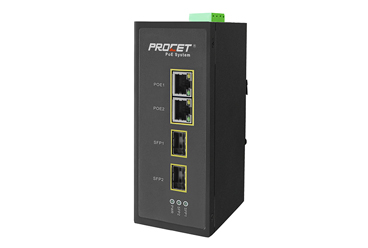Home >> News >> Company News
In recent years, the development of PoE power supply technology, from 100 megabytes to gigabit, and then to the full gigabit, PoE power supply technology is growing stronger and stronger. With a series of advantages such as simplifying the installation and deployment of electrical equipment, energy-saving, and security, PoE power supply has become more widely used in wireless coverage, security monitoring, and smart grid scenarios. However, most users still have many questions about the PoE power supply. There are seven major problems. Industrial PoE manufacturers share for you:
How to choose a POE switch for security monitoring and wireless coverage
There are many types of PoE switches, from 100M to Gigabit to full Gigabit. There are also differences between non-network management and network management, and the difference in the number of different ports. To choose the right switch, you need to comprehensively consider . Take the project that requires high-definition monitoring as an example.
Step 1: Select a standard wall-mounted PoE switch
Step 2: Select a 100M or Gigabit switch
In the actual scheme, it is necessary to select the number of cameras, camera resolution, bit rate, and frame number. Major monitoring equipment manufacturers like Hikvision and Dahua provide professional bandwidth calculation tools. Users can use the tools to calculate the required bandwidth to select a suitable PoE switch.
Step 3: Select a or at standard PoE switch
Select according to the power of the monitoring equipment. For example, using a well-known brand camera, power 12W max, in this case, you need to choose a standard switch. The power of a high-definition dome camera is 30W max. In this case, a standard switch is needed.

Poe Switch
Step 4: Select the number of ports on the switch
PoE switches can be divided into 4 ports, 8 ports, 16 ports, and 24 ports according to the number of ports. It can comprehensively monitor the power, quantity, location of the device, the power supply of the switch, and the price selection.
2. Why must we choose a standard PoE Switch for base stations to supply power?
First, the difference between a standard PoE switch and a non-standard PoE switch needs to be clarified. A standard PoE power supply switch has a PoE control chip inside, and it has a detection function before the power supply. After the device is connected, the PoE power supply will send a signal to the network to detect whether the terminals in the network are PD devices that support PoE power supply.
Non-standard PoE products are strong-powered network cable power supply devices that supply power as soon as they are powered on. There is no detection step. Regardless of whether the terminal is a PoE powered device, it is very easy to burn the access device.
Take Wangyue Technology's MS series standard PoE switches as an example. After being powered on, the switch will automatically detect the powered devices. If it detects the access of non-PoE powered devices, it will automatically stop the power supply to protect the powered devices and avoid burnout. The condition of the equipment occurs, making the power supply process more secure. The detection process is as follows. Therefore, you must use a standard PoE switch to supply power.
How to use a multimeter to measure standard POE and non-standard POE
How to distinguish between standard PoE and non-standard PoE is simple, just measure with a multimeter. Methods as below:
Start the device, set the multimeter to the voltage measurement position, and use the two multimeter pens to touch the PSE device power pin (usually 12, 36 or 45, 78 on the RJ45 port). If 48V or Other devices with stable voltage values (12V, 24V, etc.) are non-standard products. Because in this process, the PSE does not detect the power receiving equipment (here, the multimeter), and directly uses 48V or other voltage values to supply power.
Conversely, if the voltage cannot be measured, the multimeter's hands jump between 2 ~ 10V, it is a standard POE. Because at this stage, the PSE is detecting the PD end (here is the multimeter), and the multimeter is not a legitimate PD. The PSE will not supply power and no stable voltage will be generated.